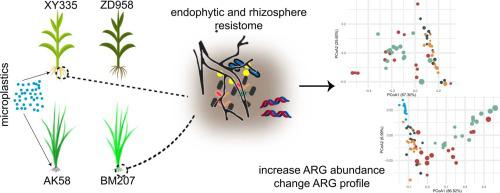Journal of Hazardous Materials ( IF 12.2 ) Pub Date : 2022-09-30 , DOI: 10.1016/j.jhazmat.2022.130091 Yuanze Sun 1 , Xinfei Li 1 , Changfeng Ding 2 , Qingchun Pan 3 , Jie Wang 1

|
The increasing One-Health concept calls for a more in-depth understanding of the dissemination of antibiotic resistance in plant microbiomes. While there is considerable published evidence that microplastics can promote the spread of antibiotic resistance genes (ARGs) in the environment, whether and how microplastics impact the plant endophytic resistome are largely unknown. Here we examined the ARGs along the soil-root continuum of maize and wheat under the pressure of microplastics. Amendment with heavy metals was also included as they can apply the selective pressure for ARG spread as well. The crop species and genotypes had significant effects on the root endophytic ARG abundance and diversity. The greatest ARG abundance was observed in the maize ZD958 endophytes (0.215 copies per 16S rRNA gene), followed by the maize XY335 (0.092 copies per 16S rRNA gene). For each crop genotype, amendment with microplastics and heavy metals significantly increased the ARG abundances and changed their profiles in root endophytes. The endophytic ARG variances were closely associated with the endophytic microbiome, the rhizosphere bacterial communities and resistome. Additionally, the level of endophytic ARGs was positively relevant to the abundance of mobile genetic elements (MGEs). These findings suggested that the root endophytic resistome was primarily affected by the crop species, and microplastics might show enhancement effects on the endophytic resistome via changing the root-associated microbiome and facilitating the MGE mediation. Overall, this study, for the first time, highlights the root endophytic ARG emergence and dissemination induced by microplastics.
中文翻译:

宿主物种和微塑料区分作物根系内生抗生素抗性
日益增长的 One-Health 概念要求更深入地了解植物微生物组中抗生素耐药性的传播。虽然有大量已发表的证据表明微塑料可以促进抗生素抗性基因 (ARG) 在环境中的传播,但微塑料是否以及如何影响植物内生抗性基因组在很大程度上是未知的。在这里,我们在微塑料的压力下检查了玉米和小麦土壤-根系连续体的 ARGs。还包括对重金属的修正,因为它们也可以对 ARG 传播施加选择压力。作物种类和基因型对根内生ARG丰度和多样性有显着影响。在玉米 ZD958 内生菌中观察到最大的 ARG 丰度(每个 16S rRNA 基因 0.215 个拷贝),其次是玉米 XY335(0. 每个 16S rRNA 基因 092 个拷贝)。对于每种作物基因型,微塑料和重金属的改良显着增加了 ARG 丰度并改变了它们在根内生菌中的分布。内生 ARG 变异与内生微生物组、根际细菌群落和抗性组密切相关。此外,内生 ARGs 的水平与移动遗传元件 (MGEs) 的丰度呈正相关。这些发现表明,根系内生抗性组主要受作物种类的影响,而微塑料可能通过改变根系相关微生物组和促进 MGE 介导对内生抗性组产生增强作用。总体而言,这项研究首次强调了微塑料诱导的根内生 ARG 的出现和传播。对于每种作物基因型,微塑料和重金属的改良显着增加了 ARG 丰度并改变了它们在根内生菌中的分布。内生 ARG 变异与内生微生物组、根际细菌群落和抗性组密切相关。此外,内生 ARGs 的水平与移动遗传元件 (MGEs) 的丰度呈正相关。这些发现表明,根系内生抗性组主要受作物种类的影响,而微塑料可能通过改变根系相关微生物组和促进 MGE 介导对内生抗性组产生增强作用。总体而言,这项研究首次强调了微塑料诱导的根内生 ARG 的出现和传播。对于每种作物基因型,微塑料和重金属的改良显着增加了 ARG 丰度并改变了它们在根内生菌中的分布。内生 ARG 变异与内生微生物组、根际细菌群落和抗性组密切相关。此外,内生 ARGs 的水平与移动遗传元件 (MGEs) 的丰度呈正相关。这些发现表明,根系内生抗性组主要受作物种类的影响,而微塑料可能通过改变根系相关微生物组和促进 MGE 介导对内生抗性组产生增强作用。总体而言,这项研究首次强调了微塑料诱导的根内生 ARG 的出现和传播。微塑料和重金属的改良显着增加了 ARG 丰度并改变了它们在根内生菌中的分布。内生 ARG 变异与内生微生物组、根际细菌群落和抗性组密切相关。此外,内生 ARGs 的水平与移动遗传元件 (MGEs) 的丰度呈正相关。这些发现表明,根系内生抗性组主要受作物种类的影响,而微塑料可能通过改变根系相关微生物组和促进 MGE 介导对内生抗性组产生增强作用。总体而言,这项研究首次强调了微塑料诱导的根内生 ARG 的出现和传播。微塑料和重金属的改良显着增加了 ARG 丰度并改变了它们在根内生菌中的分布。内生 ARG 变异与内生微生物组、根际细菌群落和抗性组密切相关。此外,内生 ARGs 的水平与移动遗传元件 (MGEs) 的丰度呈正相关。这些发现表明,根系内生抗性组主要受作物种类的影响,而微塑料可能通过改变根系相关微生物组和促进 MGE 介导对内生抗性组产生增强作用。总体而言,这项研究首次强调了微塑料诱导的根内生 ARG 的出现和传播。











































 京公网安备 11010802027423号
京公网安备 11010802027423号